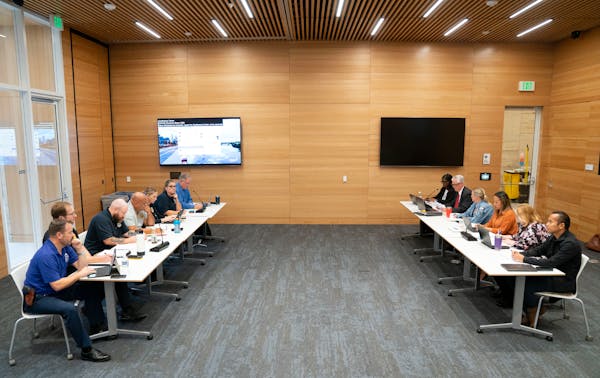Minneapolis Mayor Jacob Frey wants to build a new Third Precinct police station on a vacant city-owned lot blocks from the charred remains of the original station damaged in the violence after George Floyd's murder.
Frey announced his pick Wednesday in a letter to the City Council, in which he noted the council has failed to pick a site after months of discussion — and that the city lacks the money and time to explore additional ideas. He asked members to approve funds for the new station later this month or give him the funds and authority to move ahead.
Frey said he envisions the city's first "comprehensive safety center" at the site at 2600 Minnehaha Av., which would cost more than a traditional police station.
Frey's letter didn't include dollar figures, but a previous city analysis estimated that it would cost between $22 and $26 million to build a new station on the Minnehaha site.
It's unclear if Wednesday's development will simplify the precinct location issue, which has proven paralyzing to city leaders for years. Meanwhile, officers serving the southeast Minneapolis district continue to operate out of makeshift quarters downtown that are widely viewed as inadequate.
Frey's behest follows a confusing series of false starts and indecision that has come to typify the city's dilemma. The original Third Precinct station remains cordoned off behind razor wire, the most prominent reminder of the violence that followed Floyd's killing by a police officer stationed there.
Here's the latest and what came before:
Frey's pick
Frey had previously said he was supportive of several sites, but wanted the City Council to pick one.
Last month, he sent a letter extolling the virtues of three options and urging the council to make a selection. In response, the council eliminated one of the options.
Now, Frey is backing a single site.
"Here's why 2600 Minnehaha makes sense," Frey wrote in the letter. "First, it's located within the Third Precinct and along a major commercial corridor, so officers and community members will have easy access to the building. Second, the Council has removed the other two options provided by staff from consideration — both of which I would also support. Third, any potential site brought to the table now would cost significantly more money and time, neither of which we have."
Not-so-new site
The 2600 Minnehaha location isn't new. In fact, Frey's administration had previously elevated the site as one of two front-runners — until they abandoned it, or at least appeared to.
In March, the city announced that a Frey-directed search had narrowed the field of options to two: building a new facility at 2600 Minnehaha or renovating the previous station, which was ransacked and set ablaze but remains structurally sound.
That announcement was met with mixed responses in surveys and public meetings, including a vocal portion of community members who decried the entire process.
In July, Frey appeared to cast aside those two sites when he, City Council President Andrea Jenkins and Vice President Linea Palmisano held a news conference to announce a "medium-term" solution: moving the Third Precinct to Century Plaza on the edge of downtown, a building already slated to be the new station for the First Precinct.
Soon after, the council voted overwhelmingly to never allow police to operate out of the previous police station, although the legal weight of that vote remains unclear. Some on the council also pushed — unsuccessfully thus far — to also eliminate 2600 Minnehaha from ever hosting police.
City Council balks
In early September, the City Council balked at the Century Plaza plan when council members saw the price tag — an additional $25 million, including some empty space for future use. Council members were also troubled by a statement by a senior city staffer that cops could be operating out of the site for 10 years, which was far longer than many had envisioned.
In mid-September, the council voted to ditch the Century Plaza idea.
One theme that has been consistent among many on the council and the community: Police need to return to the physical boundaries of the precinct they patrol — an idea that could be mandated by legal agreements emerging from state and federal courts that will likely govern how the department operates for years to come.
Brooklyn Park police make arrest after asking for help in search for man suspected of sexual assault at gunpoint

Attorney Tayler Rahm wins GOP backing in battleground Second District
North Oaks withdraws request for density exemption from Met Council

